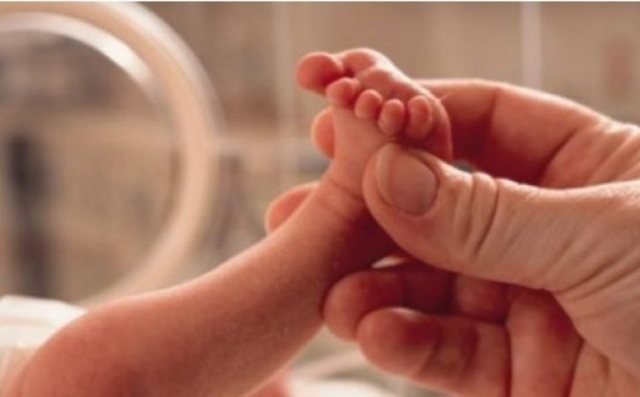
 Flash News
Flash News
Serious in Tale, Lezha! 57-year-old man executed in the yard of his apartment
Yesterday's injury in Durrës, the 36-year-old was with two minors in the car when he was shot
AMP arrests two police officers in flagrante delicto and suspends another from duty
Bomb alert in a hotel in Tirana, what the police discovered
Video/ Bomb alarm in the parking lot of a hotel in Tirana, the police react
The decline in births in Albania / What is happening in the counties of Vlorë, Gjirokastër and Kukës?

Albania is facing the phenomenon of childhood
es than the births of three decades, but in some counties the decline is much sharper than the national average.
The official INSTAT data show that in the first 6 months of the year, births on a national scale fell by 5.1%, but for the counties of Vlora, Gjirokastra and Kukës, the contraction was 2-3 times greater.
Vlora recorded the biggest drop in babies born in the first 6 months, about 16% less than in the same period a year ago. In this district in the first half of 2024, only 468 babies were born out of 556 that were born in 2023 in the same period.
After Vlora, the biggest drop in births was in the Gjirokastra District with about 14%. In this district in January-June 2024, 144 babies were born out of 167 that were born in the first 6 months of 2023.
The district of Kukës was ranked third for the high rate of decline in births with 2024. In January-June, 318 babies were born in this district with a 9.4% decrease compared to the first 6 months.
Also, the drop in births above the national average was also present in the districts of Lezha, Berat, Shkodra and Durrës.
While in Tirana, Elbasan, Fier and Korça, births fell by less than 5%.
Korça County had the lowest drop in births with only -2.3, followed by Fieri with -3.7%.
Fertility rates have fallen steadily over these three decades, but in the last two years, they have accelerated, signaling a worsening of the phenomenon in the coming years.
In 2023, just 22,210 babies were born across the country, the lowest level since 1934 when official annual data was reported.
Demographers and sociologists are concerned that births in Albania have fallen beyond all predictions.
The pessimistic scenario for population progress until 2060 developed by INSTAT predicted that in 2023, 27,281 babies would be born, but in reality about 20% less are being born.
The 2019-2031 population projections from INSTAT did not take into consideration the high immigration rates and the decline in fertility, so the demographic indicators have had a higher deterioration compared to all scenarios.
Experts claim that the policy is too late to implement a set of measures, which should focus on curbing immigration and identifying tools that can help young couples have children./ MONITOR
Latest news


PSG defeats Inter, grabs Champions League trophy
2025-06-01 09:08:08

Horoscope, what do the stars have in store for you today?
2025-06-01 08:40:10
Serious in Tale, Lezha! 57-year-old man executed in the yard of his apartment
2025-06-01 08:25:55
Temperatures up to 31 degrees Celsius, weather forecast
2025-06-01 08:15:33
Morning Post/ In 2 lines: What mattered yesterday in Albania
2025-06-01 08:01:33
Anemia increases in the population
2025-05-31 22:18:38
Elections, Noka: A farce took place in Albania on May 11
2025-05-31 21:44:55


Jola Hysaj after the result in Durrës: The vote may have been alienated
2025-05-31 20:37:16

He was shot by his compatriot in Podgorica, the young 23-year-old Albanian dies
2025-05-31 19:58:13


Ndërtime pa siguri? Humb jetën punëtori boshnjak në Tiranë
2025-05-31 18:59:42


Russian attacks kill at least seven people in Ukraine
2025-05-31 17:35:43
Study: Half of the world experienced one more month of summer in 2024
2025-05-31 17:10:40




Tragedy in Germany, small plane crashes into a residential complex, two dead
2025-05-31 15:24:43


Wanted by German authorities, 22-year-old arrested at Morina border crossing
2025-05-31 14:39:44

Threat or protection? Rama's stances towards SPAK spark contradictions
2025-05-31 13:54:59


The poisoning of children in Gramsh, proof of the destruction of state control!
2025-05-31 12:59:40

Car full of contraband cigarette cartons, 48-year-old arrested in Kapshtica
2025-05-31 12:30:43


All the people (patronage) police
2025-05-31 11:59:12
Dështon edhe seanca e 24-t, nuk ka konstituim të Kuvendit të Kosovës
2025-05-31 11:39:38



High flow of travelers at the Morina border crossing during the weekend
2025-05-31 10:20:31
Berisha will participate in the EPP Political Assembly in Brussels on June 3-4
2025-05-31 09:58:13


Today is the 24th attempt to constitute the Assembly in Kosovo
2025-05-31 08:58:30
Horoscope, discover the star forecast for your sign
2025-05-31 08:39:28
Weather forecast, how temperatures will vary throughout the day
2025-05-31 08:19:07
Morning Post/ In 2 lines: What mattered yesterday in Albania
2025-05-31 08:01:14



Bomb alert in a hotel in Tirana, what the police discovered
2025-05-30 22:05:17
The myth of 'eight hours of sleep' is debunked, here's what you need to consider
2025-05-30 22:01:55

For 7 million Lek maintenance pension, the bailiff seizes his house
2025-05-30 21:42:00



Video/ Bomb alarm in the parking lot of a hotel in Tirana, the police react
2025-05-30 20:59:35
Shots fired in Durres, one injured
2025-05-30 20:50:12
Bomb alert in the parking lot of a hotel in Tirana!
2025-05-30 20:25:46



"You know who buys votes", DP official publishes video: A witness ready for SPAK
2025-05-30 19:35:50

Kurti meets with members of the US Congressional staff
2025-05-30 18:59:14
The car is engulfed in flames on the Tirana-Durrës highway, what is suspected
2025-05-30 18:44:32







May 11/ "Bulgarian train" in Peqin, Celibashi responds to the DP
2025-05-30 16:39:25
He injured his compatriot in Podgorica, the young Albanian is arrested
2025-05-30 16:30:58
May 11th Elections, Mediu: The Electoral System Was Unacceptable
2025-05-30 16:15:04
Accident in Italy, two young Albanians lose their lives
2025-05-30 16:01:05
Get ready for the beach, high temperatures are expected on weekends
2025-05-30 15:49:07


Putin ignores Trump's warnings/Russia attacks Ukraine again with drones
2025-05-30 15:10:53

Macron: France may toughen stance on Israel if Gaza aid blockade continues
2025-05-30 14:41:14
Topalli ironizes the result in Fier: Albania in the 'club of autocrats'
2025-05-30 14:29:19
Bebe Rexha tops Billboard's list of the most streamed songs of the century
2025-05-30 14:14:52
40-year-old man injured in a chrome mine in Bulqiza
2025-05-30 13:59:30
KAS reviews DP's request for the invalidity of the elections in Dibër District
2025-05-30 13:48:08
Applications open for the "Teachers for Albania" 2025 program
2025-05-30 13:30:59

DP demands repeat elections for Kukës, KAS postpones review of appeal
2025-05-30 13:04:58

DP candidates demand recount/ Berisha: We are not blocking anyone
2025-05-30 12:41:08
Accused by Russia of supplying weapons to Ukraine, Serbia warns of investigation
2025-05-30 12:33:13

